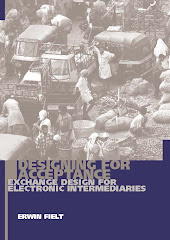Saturday, June 16, 2012
Service-oriented business models: Service as value logic
Posted by
Erwin Fielt
at
21:40
0
comments
![]()
Labels: business model, service perspective, service-oriented business model, theory
Saturday, May 19, 2012
A simple Business Model Canvas example – The library
Wednesday, February 08, 2012
Where do we find services in enterprise architectures?
In recent years, enterprise architecture (EA) has captured growing attention as a means to systematically consolidate and interrelate diverse IT artefacts in order to provide holistic decision support. Since the emergence of Service-Oriented Architecture (SOA), many attempts have been made to incorporate SOA artefacts in existing EA frameworks. Yet the approaches taken to achieve this goal differ substantially for the most commonly used EA frameworks to date.
This paper investigates and compares five widely used EA frameworks in the way they embrace the SOA paradigm. It identifies what SOA artefacts are considered to be in the respective EA frameworks and their relative position in the overall structure. The results show that services and related artefacts are far from being well-integrated constructs in current EA frameworks.
The comparison presented in this paper will support practitioners in identifying an EA framework that provides SOA support in a way that matches their requirements and will hopefully inspire the academic EA and SOA communities to work on a closer integration of these architectures.
See here for more information.
Friday, January 06, 2012
The morphology of service bundling settings
The purpose of this paper is to advance our understanding of what contextual factors influence the service bundling process in an organizational setting.
Although previous literature contains insights into the mechanisms underlying bundling and the artefacts for performing the bundling task itself, the body of knowledge seems to lack a comprehensive framework for analysing the actual scenario in which the bundling process is performed. This is required as the scenario will influence the bundling method and the IT support. We address this need by designing a morphological box for analysing bundling scenarios in different organizational settings. The factors featured in the box are systematised into a set of four categories of bundling layers which we identify from reviewing literature. The two core layers in the framework are the service bundling on a type level and on an instance level (i.e. configuration).
To demonstrate the applicability and utility of the proposed morphological box, we apply it to assess the underlying differences and commonalities of two different bundling scenarios from the B2B and G2C sectors which stress the differences between bundling on a type and instance level. In addition, we identify several prospects for future research that can benefit from the proposed morphological box.
See here for more information.






